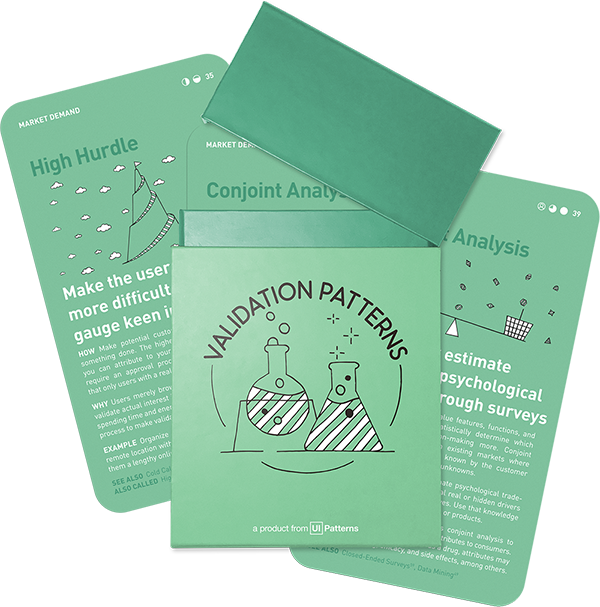Idea Validation: Product
First Click Testing
Examine what users will click on first to complete an intended task.

How: Write a clear task scenario explaining what problem participants need to solve and show a finished website, a functional prototype, or even a wireframe to observe where they click first. Time each task as a 90% first click rate on a correct label might deceptively indicate effective navigation that took 3 minutes to figure out.
Why: If users can't find what they're looking for, not much else matters. User researcher Dr. Bob Bailey found that for any given task, a user's success rate is 87% as long as their first click is correct. If their first click was not correct, the chances for success fell to below 50%.
Measure user comprehension and interface complexity
Presenting a flat screenshot or a mock up in order to subsequently ask users to click on the image to complete a task, can provide insights into how easy your interface is to comprehend – whether it is too complex to understand.
A study into usability and FirstClick Usability Testing showed that when a user’s first click is correct, he or she had 87% chance of completing an action correctly – and only 46% when the first click was incorrect.
Measuring the time it takes for users to find and click a target provide insights into how easily users can find it and will act as a useful benchmark for comparing the usability of design alternatives.
Similarly, depending on the task you give participants, first click testing can provide information about user expectations, visual clarity and whether your design patterns are readily understood.
Ask follow up questions
Especially for participants who dwell too long figuring out where to chose, it is interesting to find out more about what made them hesitate. If you are conducting the test remotely using a software tool, trigger a follow up question as the user is done clicking.
Observing users do first-click testing in real life can help generate an understanding of their frustrations. If you have that luxury, watch their facial expression, ask what goes through their mind as they body language express uncomfort or frustration.
Benchmark with the original
You are looking to find out whether your new design performs better than what it replaces. This is why it is essential to not only test your new design, but also the original. Testing the original will act as a benchmark and help you decide whether to roll out your new design or keep iterating.
Why use First-click testing for product research?
The method is aimed at evaluating the intuitiveness and efficiency of navigation within a digital interface.
First Click Testing focuses on understanding how users interact with a website or application interface when trying to complete specific tasks. By analyzing where users click first and how those actions correlate with task success, designers can identify potential navigational issues and opportunities for improvement. The goal is to create an interface that allows users to intuitively find what they are looking for, enhancing the overall user experience.
Popular tools
The tools below will help you with the First Click Testing play.
-
Chalkmark by Optimal Workshop
Online screenshot testing
-
Usability Hub
Measure how people complete tasks using your designs.
Real life First Click Testing examples
Bank of America
Mock first-click test on Bank of America’s homepage with 38 participants. They chose between search or page navigation, revealing 18% used search, while 82% clicked ‘find ATM’. Average completion time was 2.09 seconds.
Source: First-click Testing 101
Yelp event button test
To test whether Yelp users could find the Events link and which of two link options they would select, the following task wording was presented to test users:
“You’ve heard that there’s a street festival coming up in your city. You don’t know much about it, and would like to see if Yelp has any information about it.”
With 38 completing the tasks, 39% of participants went for the search bar, 37% to one Events link, and 16% to the other.
Source: First-click Testing 101
A collection of 60 product experiments that will validate your idea in a matter of days, not months. They are regularly used by product builders at companies like Google, Facebook, Dropbox, and Amazon.
Get your deck!Related plays
- FirstClick Usability Testing Study by Bob Bailey
- MeasuringU: Getting The First Click Right by MeasuringU
- First Click Testing by Gov.uk
- First-click Testing 101 by Optimal Workshop
- The vital importance of the first click by Gerry McGovern

